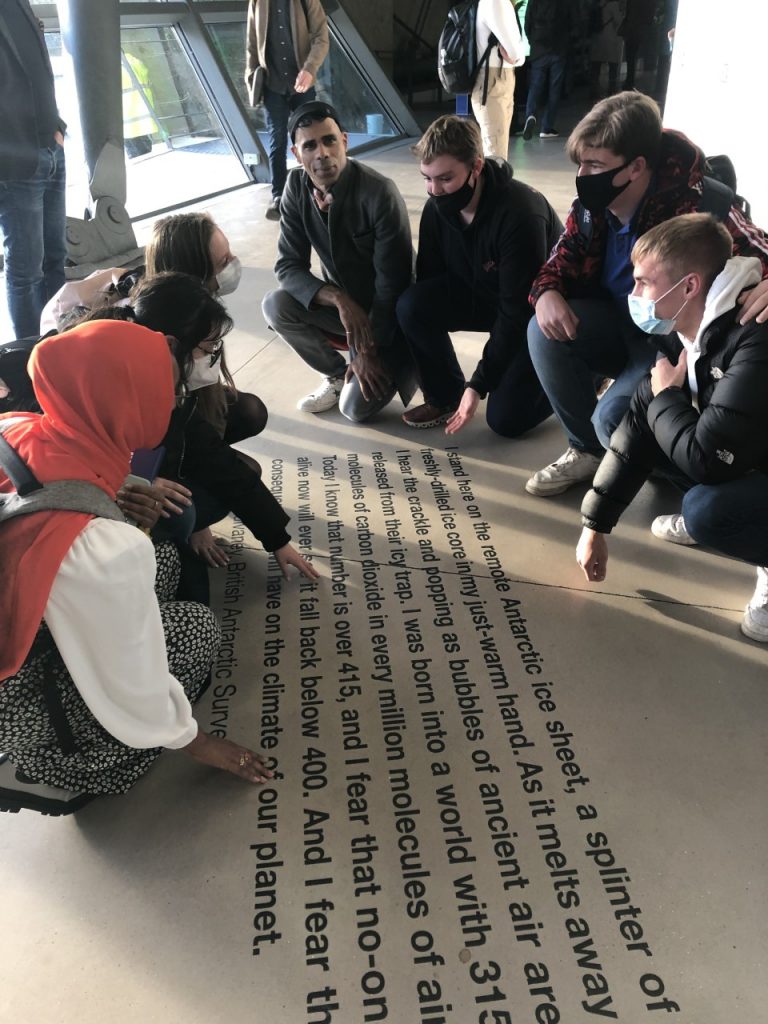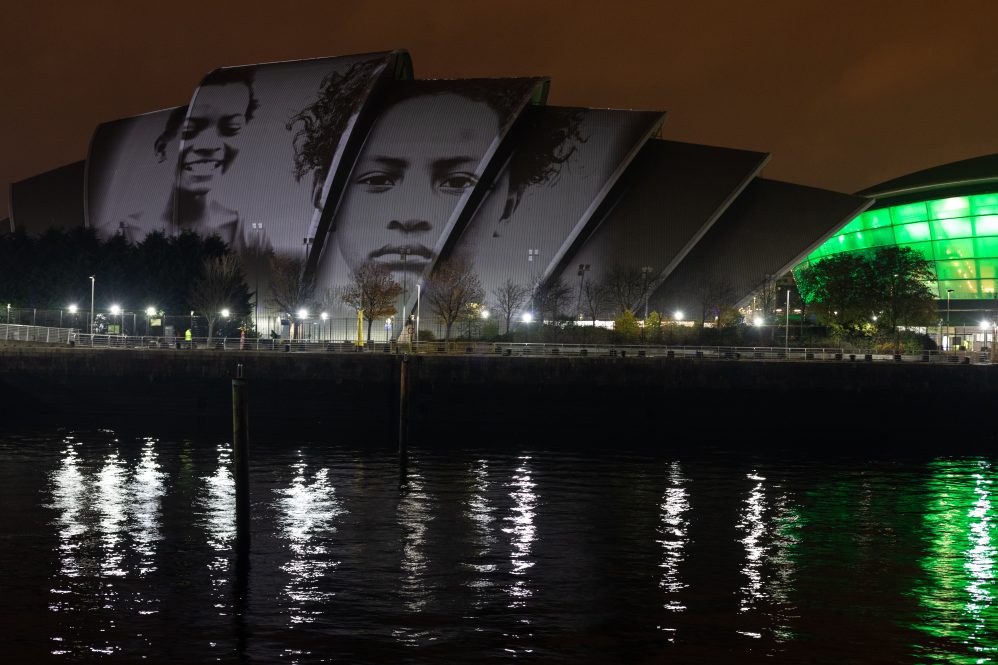COP26 in Glasgow is a massive event staged along the banks of the River Clyde. On the Northern bank, a temporary neighborhood encompassing the Scottish Exhibition Center (SEC), Hydro Arena, the Armadillo, several hotels, and acres of marquees, has been established. Labelled the “Blue Zone,” this temporary neighborhood is bounded by fencing and turnstiles and manned by security staff from around the country checking that everyone has their daily negative COVID test and invitation letter from the United Nations. Bustling with official negotiators, observers, and the media, the energy at this site is intense, reflecting the magnitude of what is at stake during these negotiations.
On the South bank of the River Clyde, lies a much more intimate sister neighborhood known as the Green Zone established around the Glasgow Science Center. The energy here is much more relaxed with an air of playfulness that befits a public arena originally designed with children in mind. Despite the lower level of intensity – or perhaps because of it – this neighborhood is of equal importance to the Blue Zone. The Green Zone embraces “museum learning,” an educational approach that invites people of varied backgrounds to engage with subject matter in an informal setting. Spaces like these have tremendous potential to communicate the extent of the climate crisis to a general audience, capturing their attention in ways that scientific data often cannot.

Artists, in particular, have a powerful role to play in environmental education, a perspective fully embraced by the University of Connecticut when it set out to define and implement its General Education requirement in Environmental Literacy. In 2018, students at the University of Connecticut presented a motion to the University Senate to implement a general education in Environmental Literacy so that no student could graduate from the university without having taken at least one class that exposed them to the complex and recursive interactions between humans and the natural environment. When a taskforce deliberated how to implement this motion once approved by the Senate, a strong consensus emerged that students needed to approach this issue in a way that was consistent with the way that they viewed and interpreted the world around them. For example, Professor Janet Pritchard from UConn’s School of Fine Arts argued that rather than take a science course, her students could become achieve an understanding of human-environment interactions through repeat photography of environmental spaces, as she had done in her work on Yellowstone. The power that comes from blending science and art is recognizing by a growing interest in STEAM projects – that blend the arts with science and technology.
An overarching interest in STEAM approaches and environmental literacy drew me to the Polar Zero installation at the Green Zone, along with UConn students Khadija Shaikh ‘24 (CLAS), Sena Wazer ’22 (CLAS), and Amanda Pastore ‘22 (MSc CLAS), three of the thirteen students who had travelled from UConn to COP26. Here, we encountered the very affable and outgoing artist and sculptor, Wayne Binitie, who explained his work. His collaboration with scientists working in the Antarctic was both impressive and inspiring. The work is multi-sensory. Visitors are able to touch the melting ice core, see the solid ice transforming into liquid, and hear the air escaping from the place that it had been trapped eons earlier. For this installation, Binitie showcases a segment of the ice core that contained air from 1765, because this is when James Watts invented the steam engine that went on to power the industrial revolution that marked the beginning of the massive acceleration in greenhouse gas emissions.
“While I spend much of my time thinking about climate change, it is often from a policy or scientific perspective. I’m thinking about how much we need to reduce greenhouse gasses to stay within the 1.5 degrees of warming, or how a specific policy would help reduce our emissions,” says Wazer. “However, when interacting with Mr. Binitie I was able to see a different side of the climate crisis. By touching an ice core from the last moments before humans started pumping enormous amounts of greenhouse gasses into the atmosphere, it gave me a moment to reflect on where we were, where we are now, and where we need to be. His art gave me time and space to reflect on all that’s been lost, but also all that is still here.”
At the entrance to the installation is a quote that exemplifies a third component of Binitie’s installation – oral testimonies from Antarctic scientists. He chose the poignant words of Dr. Robert Mulvaney, from the British Antarctic Survey:
“I stand here on the remote Antarctic ice sheet, a splinter of freshly-drilled ice core in my just-warm hand. As it melts away I hear the crackle and popping as bubbles of ancient air are released from their icy trap. I was born into a world with 315 molecules of carbon dioxide in every million molecules of air. Today I know that number is over 415, and I fear that no-one alive now will ever see it fall back below 400. And I fear the consequence this will have on the climate of our planet.”
Bintie’s presentation of the human side of climate science is an immersive experience that speaks to multiple senses with the potential to unleash in the general public a curiosity to think deeply about the issue of glacial melting and the repercussions of this and other signs of our shared climate crisis. The UConn students who had the privilege of interacting with Binitie are all attuned to climate science. But they still had something to learn about environmental communication and the power of STEAM.
Shaikh says, “I, myself am an activist artist, and creating art was actually one of the pathways in my life that got me interested and involved in environmentalism. The ability to connect with a diverse audience through an art piece is powerful as the work sends a message to be interpreted. In Wayne Beniti’s exhibit, I was captivated by the focus to sound that was created by the dripping of water droplets and the crackling of the Antarctic ice core as it melted. Sound had brought an entirely different meaning to this piece of ice as without it, I would just be using my sense of sight and touch to take in the ice core, but with hearing, I could literally hear the planet’s ice melt in front of me. I was terrified of how quickly the drops and crackling were, I was completely terrified of how this ice core was only a small sample of an ice sheet that is melting at the poles. I am grateful to have been able to visit this exhibit and especially talk to the artist, Wayne Beniti, because I was able to understand his passion, his ambition, and vision for the impact of this art work. He says, he is in the works of the art exhibit being in the Smithsonian – I sure hope one day I can be able to see that.”
“I find myself increasingly caught up in the moment. Understanding climate change creates this baseline anxiety, which places blinders on me from seeing anything but the future we are seemingly racing towards with few steps of mitigation,” says Pastore. “But, Mr. Binitie’s exhibit provided a sort of outer-body experience where hundreds of years of history were displayed in front of me, and I could touch and see the story of climate change unfolding. It was like watching a very sad scene in a movie, and walking out of the dark exhibit and into the sunlit hall was like walking back into the present with the knowledge of the past behind me. It re-framed climate change, and gave me the chance to reflect instead of continuously looking forward with anxiousness. This exhibit was truly inspiring.”
This work is a stunning example of creative approaches to imparting environmental literacy, and an important example of the power of the Green Zone to help instill in all of us the need to act to limit global warming to 1.5 degrees, to complement and perhaps even propel the negotiations taking place across the River Clyde in the Blue Zone.



